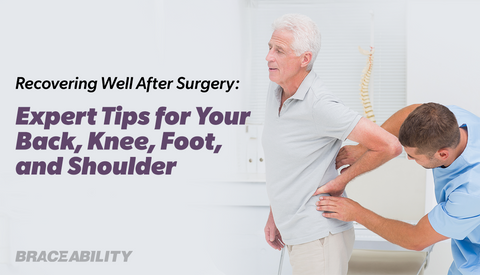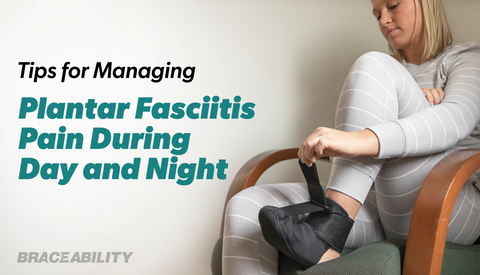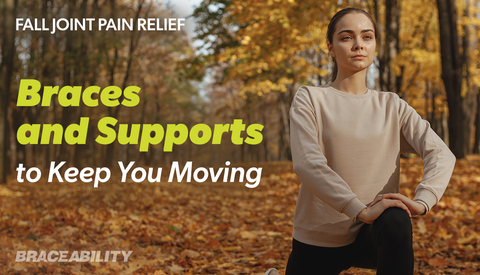Winter Arthritis Relief Tips for Holiday Comfort | BraceAbility
Don’t Let Cold Weather Slow You Down: Smart Arthritis Relief Tips for the Holiday Season
As the air cools and days shorten, many people with arthritis find their joints becoming more painful, stiff, and vulnerable. But winter doesn’t have to be a season of suffering. With the right tools, strategies, and mindset, you can successfully manage arthritis symptoms through the holidays and beyond.
The following is a comprehensive guide to understanding why cold weather inflames arthritis and how to stay active during holiday tasks like cooking, shopping, and travel. It also explains when to use supports such as bracing, including your own knee, back, and thumb brace lines, and when rest is the smarter choice.
Why Arthritis Often Gets Worse in Cold Weather
Arthritis may flare in winter for several interrelated reasons:
-
Barometric pressure shifts: Falling atmospheric pressure can let tissues around joints expand slightly, stretching joint capsules and triggering pain.
-
Constriction of blood vessels: Cold causes vasoconstriction, reducing circulation to muscles and joint tissues and contributing to stiffness.
-
Muscle “guarding”: To retain heat, muscles tend to tighten (guard), placing extra stress on already vulnerable joints.
-
Reduced movement: People often move less in cold months, which can lead to muscle deconditioning and tighter, less lubricated joints.
-
Increased sensitivity: Cold can heighten nerve sensitivity, lowering the pain threshold and making even small stresses feel worse.
Because of all that, mundane tasks like holiday cooking or shopping can feel like uphill battles when your joints are already on edge.
Winter Health Tips for Holiday Cooking, Shopping & Travel
Here’s how to keep joint pain under control during the busiest (and coldest) season of the year:
1. Start with a Gentle Warm‐Up
Before any heavy or longer activity, do 5-10 minutes of gentle range-of-motion movement (arm circles, ankle pumps, light squats). Combine that with a warm shower or moist heat pack to loosen tissues and prep joints.
2. Dress Smart & Keep Joints Warm
Layering is your friend. Use thermal base layers and outerwear that trap heat without bulk. Add thin heat wraps or soft compression sleeves over vulnerable joints (knees, wrists, thumbs) to maintain warmth and reduce stiffness.
3. Plan Breaks and Pace Yourself
Break long tasks into smaller chunks. If you’re baking for hours or strolling through a mall, insert rest periods to stretch, hydrate, or simply sit and relax. Use seating in stores or kitchen stools when possible.
4. Use Ergonomic Tools and Aids
Switch to kitchen utensils with wide, cushioned handles to reduce strain on finger joints. For shopping, opt for wheeled carts or backpacks instead of carrying heavy bags. During travel, choose luggage with wheels and handles rather than lifting heavy loads.
5. Travel with Joint Health in Mind
-
On long car rides or flights, stop every 1–2 hours to stretch and move.
-
Use pillows, lumbar rolls, or rolled towels to maintain spine alignment.
-
Wear joint supports during long stationary periods (e.g. flights) when motion is limited.
6. Strategically Combine Heat and Cold
-
Before activity: Apply moist heat (heating pad or wrap) for 10-15 minutes to relax muscles and increase flexibility.
-
After activity: Use cold (ice packs or chilled gel wraps) for 10-15 minutes to reduce swelling.
-
Intermittently: Use topical gels (menthol, capsaicin, NSAID creams) as tolerated - but always use a test patch first and follow instructions.
7. Stay Active (Within Reason)
Even in cold weather, low-impact exercise such as walking, elliptical, or yoga helps keep muscles and joints supple. Aim for consistency over intensity: 10 to 15 minutes daily is often more helpful than spotty marathon efforts.
8. Optimize Sleep and Recovery
Warm your bedroom before bed and consider a lightweight shawl or robe easily accessible for when you wake in the night. Use pillows to maintain proper joint alignment while sleeping so you don’t wake with stiffness.
9. Eat Smart & Hydrate
Cold weather can blunt thirst signals, so consciously drink fluids. Prioritize anti-inflammatory foods (oily fish, berries, leafy greens, turmeric) and limit processed sugars, refined carbs, and trans fats that can feed inflammation.
10. Manage Stress & Mindset
Holiday demands and seasonal gloom can raise stress, which in turn amplifies pain. Incorporate breathing exercises, short movement breaks, or mindful moments into your routine to keep tension from driving your symptoms higher.
Bracing vs. Rest: Finding the Right Balance
You don’t have to choose between “brace all the time” or “never brace.” Smart use of supports combined with rest is often the key to stable symptom control.
When to Use Supports (Bracing, Compression, and Splints)
-
During prolonged or high-stress tasks: Cooking, shopping, travel, or standing for long periods are all times when a brace can stabilize the joint and reduce microtrauma.
-
In flare-ups or instability: If a joint feels wobbly, painful, or swollen, a brace helps offload stress and provide stabilization.
-
Preventively on “known” joints: If you have joints that chronically flare (knees, back, thumbs), wearing support during known stress periods can reduce exacerbations.
-
During rehabilitation or post-procedural care: After injections or therapy, braces can guard the joint while promoting safe movement.
In those moments, a brace is a supportive assistant, not a permanent crutch. Over-reliance can weaken muscles over time.
When Rest or Reduced Load Is Preferable
-
During acute inflammatory flares: If joints are hot, swollen, and sharply painful, rest, cold therapy, and elevation may trump bracing.
-
When overuse warning signs emerge: If tingling, numbness, or increasing stiffness appear, that’s a red flag to slow down or pause.
-
At night (unless medically directed): Many braces are not designed for overnight wear and constant use can reduce circulation or muscle tone.
The “sweet spot” is alternating support during activity with rest during inflammatory periods. Always consult a physician or PT to customize what joints to brace, which types (sleeve, hinge, splint), and timing.
Supportive Bracing Solutions for Cold-Weather Arthritis Relief
When temperatures drop, targeted support can make a big difference in keeping joints stable, warm, and comfortable. Consider these three BraceAbility solutions, each designed to help manage arthritis pain in different areas of the body during the colder months.
1. For Knee Arthritis or Stiff Joints:
A knee brace or compression sleeve can provide warmth and gentle compression to improve circulation and reduce stiffness. Look for breathable, flexible materials that move with you while offering extra stability during daily activities like walking, cooking, or climbing stairs.
2. For Back or Hip Arthritis:
Cold weather often worsens stiffness and tension in the lower back. A supportive back brace helps maintain alignment, ease muscle strain, and retain soothing warmth while you move or rest. It’s especially helpful during long car rides or hours spent standing in the kitchen during holiday prep.
3. For Hand or Thumb Arthritis:
When your hands ache in the cold, a thumb or wrist brace can help protect sore joints and prevent painful overuse. Wearing light compression support while shopping, cooking, or wrapping gifts can reduce inflammation and make everyday tasks more manageable.
For added relief beyond daytime activity, explore our Sleep Comfort Tips While Dealing with Injury or Condition blog for practical ways to stay warm, supported, and well-rested through the colder nights.
No matter which injury or condition you’re managing, supportive bracing at night should feel secure yet comfortable, not overly tight or restrictive. Pairing the right brace with a calming bedtime routine and ergonomic pillow setup can go a long way in promoting deeper, restorative sleep.













